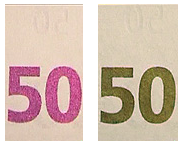Optically variable ink
The examples and perspective in this article may not represent a worldwide view of the subject. (April 2021) |


Optically variable ink (OVI) also called color shifting ink is an anti-counterfeiting measure used on many major modern banknotes, as well as on other official documents (professional licenses, for example).
The ink displays two distinct colors depending on the angle the bill is viewed at. The United States fifty-dollar bill, for example, uses color shifting ink for the numeral 50 so that it displays copper at one angle and bright green in another.[1]
OVI is particularly useful as an anti-counterfeiting measure as it is not widely available, and it is used on security printing. One major manufacturer is a Swiss company called SICPA (Société Industrielle et Commerciale de Produits pour l'Agriculture). Additional suppliers include German company Gleitsmann Security Inks, Sun Chemical (through their Brand Protection Division based in Manchester, UK), and the Swiss company Printcolor AG, located in Berikon, Switzerland.
Color-shifting inks reflect various wavelengths in white light differently, depending on the angle of incidence to the surface. An unaided eye will observe this effect as a change of color while the viewing angle is changed. A color copier or scanner can copy a document only at one fixed angle relative to the document's surface.[2] It uses finely powdered pearlescent glitter.
Optically variable magnetic ink
[edit]Optically variable magnetic ink (OVMI), also called SPARK,[3] has visual effects that are based on the magnetic properties of the ink. When the document is tilted, movement of a bright light stripe occurs and the colour changes. It is usually applied by screen printing. This type of ink is used for the Euro,[4] Brazilian real,[5] and Russian ruble banknotes.[6]
References
[edit]- ^ "New design for the US $50". www.sicpa.com. SICPA. Archived from the original on 16 October 2006. Retrieved 24 July 2006.
- ^ "3rd ICAO MRTD Biometrics and Security Standard Symposium - 2007" (PDF). www.icao.int. International Civil Aviation Organization. Archived from the original (PDF) on 19 December 2008. Retrieved 7 December 2007.
- ^ "Glossary of Banknotes - Optically Variable Magnetic Ink (SPARK, OVMI)". regulaforensics.com. Regula Forensics. Archived from the original on 16 January 2020. Retrieved 12 November 2018.
- ^ "Security features - Europa series €100 banknote". www.ecb.europa.eu. European Central Bank. 11 September 2018. Archived from the original on 12 November 2018. Retrieved 12 November 2018.
- ^ "GET TO KNOW THE BRAZILIAN BANKNOTES". www.bcb.gov.br (in English, Portuguese, and Latin American Spanish). Central Bank of Brazil. Archived from the original on 12 November 2018. Retrieved 12 November 2018.
- ^ "Banknotes". www.cbr.ru (in Russian and English). Central Bank of the Russian Federation. Archived from the original on 12 November 2018. Retrieved 12 November 2018.
